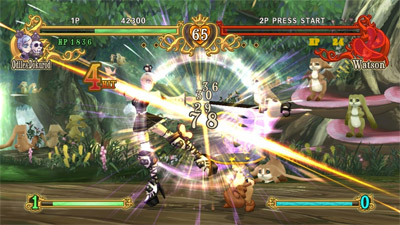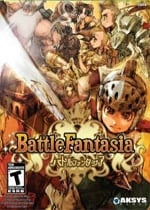A Stylish Beat-down
Everyone knows the golden age of fighting games came and went in the early-to-mid ’90s. In particular, the Mortal Kombat and Street Fighter II series combined manageable rosters (a reasonable number of characters with a few special moves each) with addictive gameplay that depended more on timing than on complicated button patterns.

Japanese arcade title Battle Fantasia has been billed as a throwback to that era, but it actually traces its roots more to the time just after that, the Killer Instinct period, when the games were still 2-D but started to feature complicating gimmicks like combos and breakers. Battle Fantasia is a fun arcade brawler with a unique visual style, but the console version’s new features aren’t impressive enough to make it a worthwhile buy.
Upon slapping the disc in, immediately noticeable are the artistic, cel-shaded graphics, which give off an anime vibe. The characters are modeled in 3-D even though the action is two-dimensional, and the animations are fluid. Backgrounds vary remarkably; it’s not unusual to go from a stage with a dark, moody dungeon atmosphere to a scene straight out of Bambi, with woodland creatures scattered about. However, though well-done, these visuals are far from breathtaking, given the competition from major-studio fighters.
The Japanese influence runs far deeper than the graphics. English writing often appears beside Japanese symbols, and characters converse in the game’s native language (only the announcer speaks in English, and when necessary, the characters’ translations are subtitled). Hearing a lot of babbling in a tongue you don’t understand can get grating, especially for innocent bystanders sitting in the room where you’re playing.

On the game’s main menu one can access the options screen (go there first, because auto-save is off by default, and the only other way to keep your progress is to come back to the options menu after playing and save manually) as well as the various game modes. Most of the modes are straightforward: you can tackle the game arcade-style (building up to a final boss match against Deathbringer and an anticlimactic ending consisting of a sketch of your character), see how many opponents you can beat in a row, play for speed, practice, or take on other humans on one console or online.
These simple modes serve as a great place to learn the fighting system. There are 12 characters total, and they run the gamut of quirkiness. There are a few standard anime fighters (females with girlish mannerisms and fast, vicious attacks; males in the mold of Link), but there’s also a Harry Potter-looking dude in a robe with a cross on it, a masked outlaw, a rabbit wearing a poofy hat shaped to fit his ears, a fat guy with white hair and a beard (hmmm), and a boy wielding what appears to be a lightsaber chainsaw.

Most of these characters’ abilities are easy to learn, with responsive controls based around a standard scheme (four attack buttons, a throw button, push up to jump and away to block). Each has a few special moves based on SFII-style button patterns, though some of the more difficult fighters can chain their attacks.
To spice up these basic mechanics, Battle Fantasia throws in the “Heat Up” and “Gachi” systems. Each time you hit your opponent or get hit yourself, the “MP” bar at the bottom of the screen fills up a little; when it’s full, you can use Heat Up to set your character on fire temporarily. This increases your strength and makes more moves available. The Gachi button, often compared to the parry system in Street Fighter III, counters attacks instead of just blocking them, leaving your opponent briefly vulnerable.
The fights also feature some RPG-style gimmicks. Watson (the rabbit who presides over Bambi-land), but no other character, can “level up” during the fights. The noble-sounding, orchestrated music could easily have worked in a Final Fantasy game. Each round is a “chapter.”

Also, in addition to the traditional fighting-game energy bars, Battle Fantasia assigns a total number of “hit points” to each character; with every blow, a number pops out indicating how much damage was dealt. The addition is both distracting and useless, as the energy bar is much better than the hit-point count at letting you know how the match is going. If both bars are halfway full, you’re in an even fight, and if you’re down to a quarter of your bar but your opponent still has half, you’re losing, even if you have more “hit points” left than he does. Also, it makes the game feel uneven, even though, in fact, the characters are well-balanced. Some fighters have more than double the HP of others, but that’s because other deficiencies (speed, etc.) make up for it.
One would think that Story Mode, the heart of Battle Fantasia’s console additions, would be the perfect place to showcase role-playing influences. It’s not hard to imagine a classic RPG where an enemy encounter leads to a fighting match rather than a turn-based battle. Unfortunately, in Battle Fantasia this is not the case. Rather, the story mode is little more than a re-tread of the arcade mode, with a skippable storyline that strings together a series of one-round matches for each character. (The stories usually involve fighting an evil force called the Scion of Ill Presage, though some characters do so directly while others take a more roundabout, lighthearted route.) The mode doesn’t even add variety the way the Soul Calibur games do, by putting interesting restrictions (say, throws only) on some of the fights. The tale is narrated in Japanese with English subtitles, with embarrassingly simple animations of the characters talking against different backgrounds.
There is a silver lining, though, in that story mode will provide hardcore players with lots of replayability. As un-engrossing as the plot may be, it branches in different directions depending on whether you win or lose battles, and whether you meet certain conditions during the battles. You’ll have to play through each story multiple times to reach 100 percent completion. (Depending on how many attempts each battle takes, each journey through the game takes about a half-hour to an hour.) Still not enough? Ramp up the difficulty and do it again, or head online.
In other words, once Battle Fantasia grabs hold of a player, there’s no telling how many hours of enjoyment it’s good for. However, given that fighting fans can already spend full price to get Soul Calibur IV, download classic brawlers for dirt cheap, and even buy compilation discs loaded with old-school punch-and-kick action, this title doesn’t quite have what it takes to justify its price tag.
RATING OUT OF 5 RATING DESCRIPTION 3.8 Graphics
Very stylish and inventive visuals, but Battle Fantasia lacks the attention to detail seen in bigger-budget games. 4.2 Control
Smooth and responsive. 3.5 Music / Sound FX / Voice Acting
Majestic music and decent effects, but the characters’ dialogue is all in Japanese. 3.9 Play Value
It’s unlikely you’ll get really engrossed in this game, but if you do, it’ll take hours to reach 100 percent completion on all the stories, and even then you can ramp up the difficulty. 3.8 Overall Rating – Good
Not an average. See Rating legend above for a final score breakdown.
Game Features:
